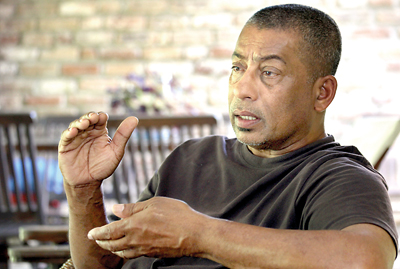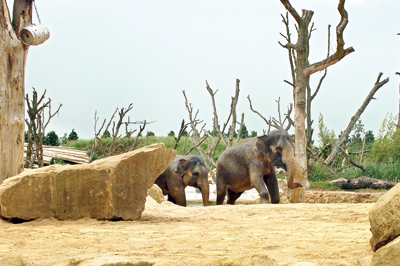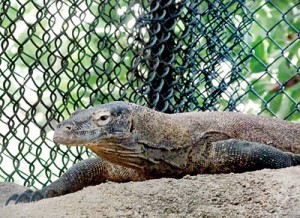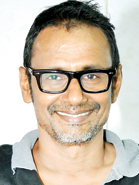Zoo man’s wild vision
There is a place in far off England dedicated to tiny Sri Lanka. ‘Uda Walawe’ elephant habitat and walkway at Twycross Zoo in the English Midlands modelled on our very own Uda Walawe National Park brings into focus the Sri Lankan elephant in its natural habitat and also the reverence with which this majestic creature is held in the Asian subcontinent.

Vasantha at home in Kandy. Pic by M.A. Pushpa Kumara
The man behind England’s ‘Uda Walawe’ is Vasantha Nugegoda of ‘Design for Life’ who himself concedes that he is very much a “zoo person”. Based in Melbourne, Australia but a frequent visitor to his motherland, his touch is not just limited to Twycross Zoo.
For his name is strongly linked to the first Night Safari in Singapore as well as the second and third Night Safaris in China and Chiangmai in Thailand.
The unique ‘Uda Walawe’ experience at Twycross, conceptualised by Vasantha, a well-known zoologist and animal habitat specialist leads men, women and children through a jungle pathway opening onto a Sri Lankan vista – replete with icons. A caparisoned perahera tusker portraying the rich cultural heritage of Sri Lanka, a typical kopi kade, the humble home of a farmer, a lotus-studded tank and a replica of Lord Ganesh, the Elephant-God.
Meeting Vasantha at his ancestral home in Kandy, just before he leaves for Australia, it is easy to imagine the pathway that has led him to do what he does – a finely intertwined hobby and job, being with animals.
“Elephants were in and out of our home,” smiles Vasantha’s mother, Gnanawathie Menike Dissanayake, who turns 93 on December 26. Clad in a Kandyan saree, Gnanawathie from Hendeniya who married into the Nugegoda Walauwwe at Gohagoda, recalls how elephants were very much a part of their lives.
Of the three elephants they had, she remembers ‘Valli’ a very friendly cow-elephant and a baby, so young that they had to bottle-feed the milk to it. Even after Gnanawathie married and moved out, many were the weekends and holidays that she would take Vasantha back home and she still treasures a yellowed news clipping about the ‘Wild Boy’ who had his own zoo. It referred to none other than Vasantha.
“It was also not only my mother who was a lover of wild animals,” says Vasantha, explaining that his father, Tikiri Banda Nugegoda, who implemented the colonisation schemes in Kala Wewa and Kagama would bring home all the wild animals whose habitats had gone under cultivation.
“Our home was known as ‘Saththu Walauwwe’,” quips Vasantha who had pets ranging from jungle cats, fishing cats and jackals to monkeys, pythons, bear cubs, numerous birds, donkeys, ponies and even a cross between a pony and a horse.
Trinity College where he schooled was no different. Although he would disrupt lessons when he wanted to play truant by pulling out a python from his bag or signalling to the wild monkeys to converge on the classroom on cue, college too was a park. “We would be taken for a walk to Udawattekelle before assembly where we watched intently the behaviour of flying foxes, otters and mouse deer while college itself had lots of fruit trees and animals. We also had to work on the college farm where animal husbandry became second nature,” he says.
This is why all Trinitians care for nature and are very much the sons of the soil, he says, adding with a smile that those days “we didn’t study”. Their careers were in planting or the army.
And so, Vasantha’s father thought that he would take to planting. But young Vasantha had a different plan. He remembers clearly how his father advised him “never to make your hobby a career” when he wanted to work at the Dehiwela Zoo but had been persuaded by Dr. T.S.U. de Zilwa to let “this unhappy child” do what he wants.
Vasantha had already gathered experience at the Smithsonian Institute where he had indulged in research on primates, when Dr. de Zilwa introduced him to then Zoo Director and eminent conservationist Lyn de Alwis. There were vacancies only for casual animal-keepers.
So it was that he got to work not only with Lyn and his team including T. Sivasamu, “beautiful people” who were totally committed but also minor employees who were honest and dedicated to the job they were doing.
Given a one-year deadline by his father to overcome his madness, it had been Lyn who had persuaded him to let the lad follow his dream. There was no turning back.
Having been the General Curator of the Dehiwela Zoo and obtaining an Advanced Certificate in Animal Management from the London Zoo and also training at the Jersey Channel island which was under famous naturalist Gerald Durrel, it was to Singapore that he went to work as a Zoologist when the first Night Safari in the world was being set up under an international team headed by Lyn de Alwis. It was here that Vasantha became Coordinator for the native animal re-introduction programme, a first for Singapore under which mouse deer etc were re-introduced to the forests there.
Hands-on Vasantha is now heavily into naturalistic design and landscaping, giving of his expertise to the breeding of highly-endangered species while also training animal keepers and operations staff.
His company provides consultancies to design zoos, safari parks, national parks and conservation centres. Currently Vasantha is part of the team setting up a safari park on the island of Cebu in the Philippines and also “building up a place” in Putra Jaya for two giant pandas given on loan to Malaysia by China, while winging his way to England to see how his ‘Uda Walawe’ baby is doing at Twycross and to China’s Xiangjing safari park which houses thousands, being the “largest collection of zoo animals in a safari park” anywhere in the world.
Working with architects, engineers and other staff, Vasantha comes up with ideas on modern exhibits. The modern concept is open areas sans fences and cages, according to the animals’ behavioural patterns and adaptations, points out Vasantha, explaining that if it is for monkeys, there should be a lot of trees and for elephants, large areas for them to roam, grasslands, wallowing areas and adequate water.
“I copy nature because nature is unique,” is his simple explanation about the re-creation of environments for animals. Modern zoos are not about cages, and his pivotal role is to ensure that the animals are happy, healthy and productive while safeguarding visitors. Giving just one example, he is quick to point out that barriers for animals could come in the form of agal (drains cut into the ground).

‘Uda Walawe’ elephant habitat and walkway at Twycross Zoo in the Midlands, England
Back to what seems to be an obsession, elephants, Vasantha reverts to his pet project of ‘Uda Walawe’ at Twycross, “the only permanent monument of its kind to be built in the west themed after Sri Lanka”.
Ironically, the four cow-elephants at Twycross are from Vietnam and Burma and Vasantha is strident in his call that Sri Lanka should send elephants from Pinnawela to countries which request them, but with the strict proviso that those countries should be first put under the microscope with regard to the facilities available, their animal ethics records and also staff training.
He urges that after such a deal is struck for “priceless” elephants, the package should include proper publicity for Sri Lanka and a good return in the form of animal exchanges, training for keepers, upgrading of facilities here etc. Like getting a dam built across the river in Pinnawela so that the elephants would have water even when the drought sets in.
Contrasting China with Sri Lanka, he says when the Chinese government loans giant pandas to another country, in recent times Singapore, the recipient has to donate around US$ 1 million for panda conservation. However, in most places where we have given elephants to, there is only a tiny and hardly-seen board to indicate that the animal is from here. There is absolutely nothing about our country as a hub of elephant conservation, he laments.
Vasantha’s stand is clear: Sri Lanka’s elephants should be sent to good zoos for breeding and not just to be exhibited in those countries for those countries to increase their revenue.
Talking with facts in hand, he says that Japan and Prague were good choices and picks out the latter to give a lesson. Prague wanted an elephant for breeding and the holding facility was designed well, with an indoor section to shelter the elephant in extreme cold. Just a cement floor during the winter is not good enough, he explains, stressing that there should be thick bedding of either sand or saw-dust over the cement. Otherwise most animals in the west fall victim to foot problems.
It’s a big “No, no” from him with regard to Armenia, New Zealand and also the Philippines. Critical of Armenia’s “horrible” facilities, he adds that even those in New Zealand are not up to mark. New Zealand has an old female elephant beyond the breeding age and is on the look-out for two young cow elephants. Where is the bull elephant for breeding, he questions, answering that artificial insemination is not the answer. Why doesn’t New Zealand get a few of the surplus bull elephants from Australia’s Sydney Zoo?
Referring to the Philippines, Vasantha explains that a Sri Lankan elephant sent a long time ago to the Manila Zoo is in deep trouble because the facility does not have the money to feed or look after it. Zoo officials are now attempting to relocate it in Thailand but it will face hard times, having to join a herd there at the bottom-rung and being pushed, shoved and whacked by those elephants. Transporting the elephant there would also cause issues. Similarly, Sri Lanka should not accept animals if it does not have the adequate facilities.
Advising that it is not good for the wellbeing of social animals to be sent alone, he urges that as in the case of gorillas to prevent stress and encourage breeding, small groups of elephants should be sent out to good foreign zoos.
Recently China had got 10 elephants from Borneo and this group now has eight babies. Exchanging animals is essential to prevent inbreeding and get new blood, Vasantha says, adding that Sri Lanka should be forward-thinking and not get “deleted” as in the case of the sloth bear. As Sri Lanka was unable to send sloth bears to European zoos, they “deleted” them and do not showcase the sloth bear.
Zoos are conservation centres, Vasantha says, adding, animal exchanges are essential, but need to be done scrupulously.
‘Give me land, and I’ll give you bio-parks’
Vasantha has a dream for the men, women and children of Sri Lanka. Small bio-parks should be set up in every city for people to “see, touch and interact” with both fauna and flora. “Just give me five acres in every city. I only need the land. It will not be a money-making exercise,” urges Vasantha.
It is only then that people will learn to respect nature and understand that nature is very important for our survival, he adds.
Follow @timesonlinelk
comments powered by Disqus























